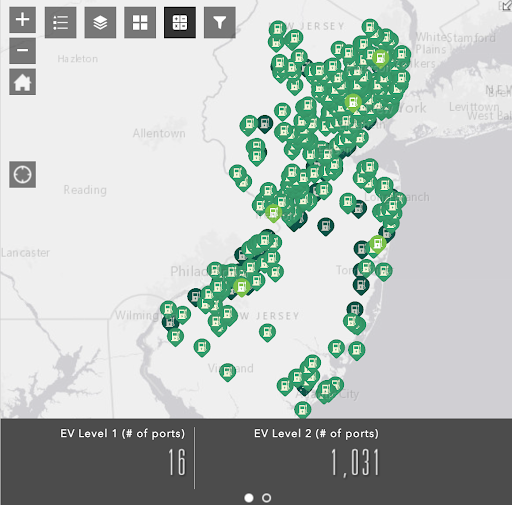Worried you can’t find a charger for your EV? It’s easier than you think
Many New Jerseyans are worried about transitioning from a gas car to an electric car for fear of not being able to find a charger. Fear not - not only are there hundreds of publicly accessible chargers across the state, but 70-80% of all charging happens at home. And more charging stations are being installed at convenient locations every single day.

During the pandemic, I, like many others, have been driving significantly less than ever before, and yet my gas tank still needs to be refilled every once in a while. I find myself making special trips to the gas station to refill my tank that I didn’t use to make, and thinking, “Why is this still a thing that I have to do?” Well, if I had an electric vehicle, then I would never have to do it again.
The most commonly cited reason why people won’t switch from gas to electric cars is a phenomenon known as “range anxiety,” or the fear of not being able to find a charging station. I never once worried that I wouldn’t be able to fill up my car, because as every New Jerseyan knows, there is a gas station on nearly every corner in nearly every downtown across the state, and off of every exit of our extensive highway system. However, what most people don’t yet know is how prevalent electric vehicle (EV) charging stations are becoming and how much simpler it is to charge an electric vehicle than it is to fill up with gas.

There are 590 public electric vehicle charging stations in the state, with thousands more privately owned at homes, apartments, workplaces, hotels, and more. Additionally, more than 80% of all EV charging occurs at home, making the need for publicly accessible chargers lower than most people think. Yes, it’s nice to know there’s a charging station available if you’re running low on juice or interested in taking a road trip, but most of the time you won’t need to use them.
Finding an EV charger is really easy — here are a couple of easy ways to find a charger:
- Use the New Jersey Department of Environmental Protection’s Electric Vehicle Charging Locator (pictured above)
- Use the Chargehub app or chargehub.com
- Use the PlugShare app or plugshare.com
There are a few things to know about EV charging to demystify the process:
1. Levels
There are different levels of charging stations, which will charge your vehicle at different speeds, level 1, level 2 and level 3, also known as DC (direct current) fast chargers. Level 1 chargers are 110 volt wall outlets, or basically plugging your car into the wall in your garage. This is a viable option that many people utilize, charging an EV at about 4 miles of range per hour. For someone who drives 30 miles a day, has access to a wall outlet overnight or at work, and can let their car sit and charge for 6 hours at a time, this is perfect. Level 2 chargers are 220-240 volts and are high powered wall outlets that many homes have to power appliances like ovens or dryers. They charge the average EV at a rate of about 25 miles per hour. Third are DC fast chargers, or level 3 chargers, which are about 400 volts and can provide over 100 miles of range per hour. These charging stations are generally located at rest stops along highways and are pricey to give you that much range that quickly. Not all vehicles are able to charge at level 3 charging stations, so know that before you hit the road.
2. Charging plugs
Not all EVs are compatible with all charging stations, unfortunately, and not all use the same type of plugs. When you buy or lease your EV, it will come with a level 1 charging plug. This will be either a NEMA 5-15 or NEMA 5-20 plug depending on the vehicle. To charge at a level 2 charger, you need different equipment than what came with your vehicle. All EVs in the US, that are not Teslas, use the J1772 plug, which is considered the standard in all of North America. Tesla has its own standard connector for level 2 charging. You can buy an adapter to allow you to use any level 2 charger while out and about, or charge at Tesla charging stations with no adapter (if you drive a Tesla). Non-Teslas can not charge at Tesla charging stations. Tesla also has its own plug for level 3 or fast charging, which can be done at Tesla Superchargers. You don’t need any specific connector or adapter, but you can only charge a Tesla at these charging stations. All other EVs need either a CHAdeMO plug (specific to Nissan, Mitsubishi, Kia, Fuji, and Toyota) or a SAE Combo (for BMW, Volkswagen, Chevrolet, all other upcoming American and European EV models) for level 3 charging.
So, once I replace my gas car with an electric vehicle, I’ll never have to worry about taking a special trip to the gas station again. If my battery is running low, I can simply plug my car into the wall with the level 1 plug that came with my car. Or, maybe I’ll go out to dinner and plug my car into the level 2 charger in the parking lot with my J1772 plug. By then, charging stations will be everywhere in New Jersey, not just because EVs are so popular that businesses are installing them proactively, but also because state law says there will be 1,000 level 2 chargers in New Jersey by December 2025 funded through the It Pay$ to Plug In program. So, now what’s your excuse?
Topics
Authors
Hayley Berliner
Find Out More

Cleaner air in Steel City

A look back at what our unique network accomplished in 2023

How much does American driving contribute to global climate pollution?

